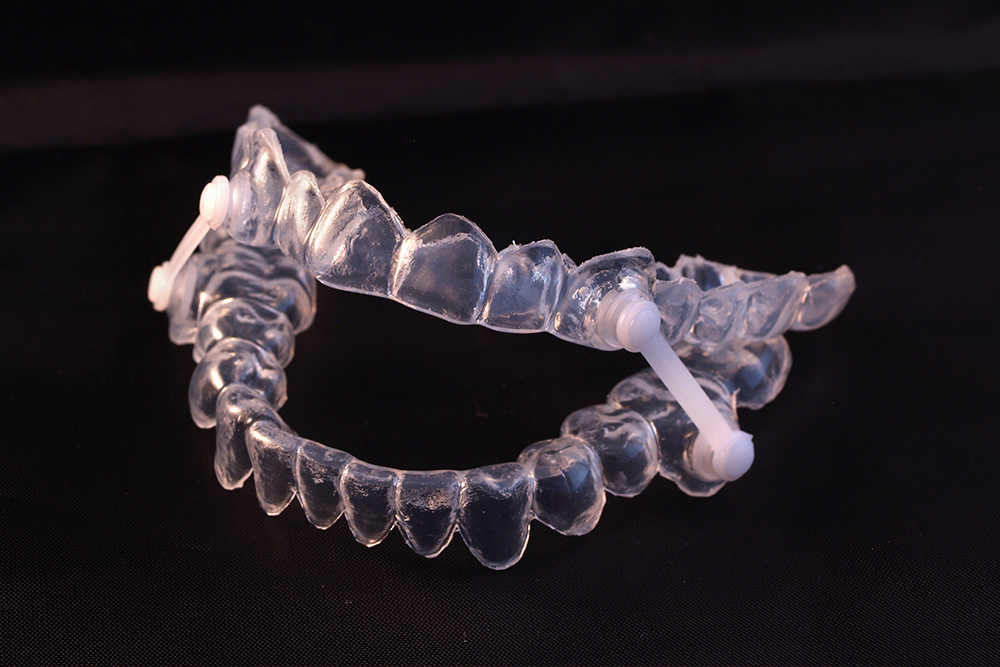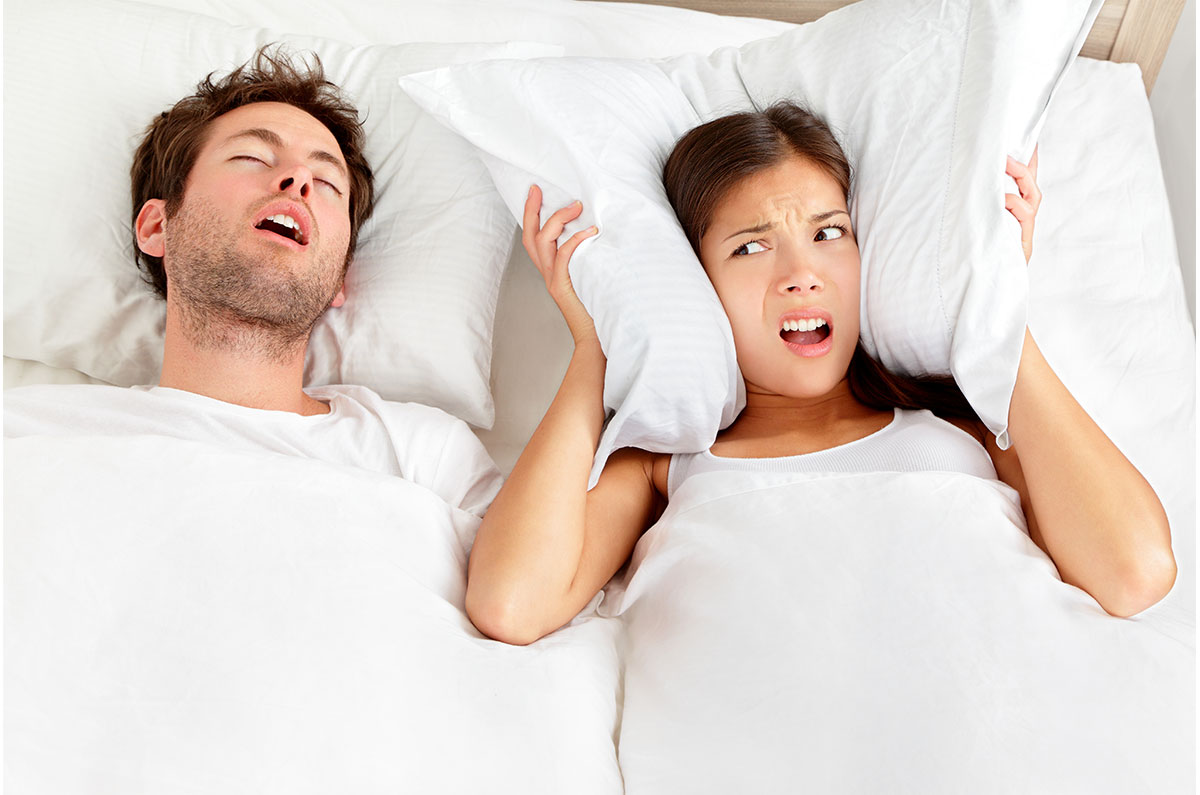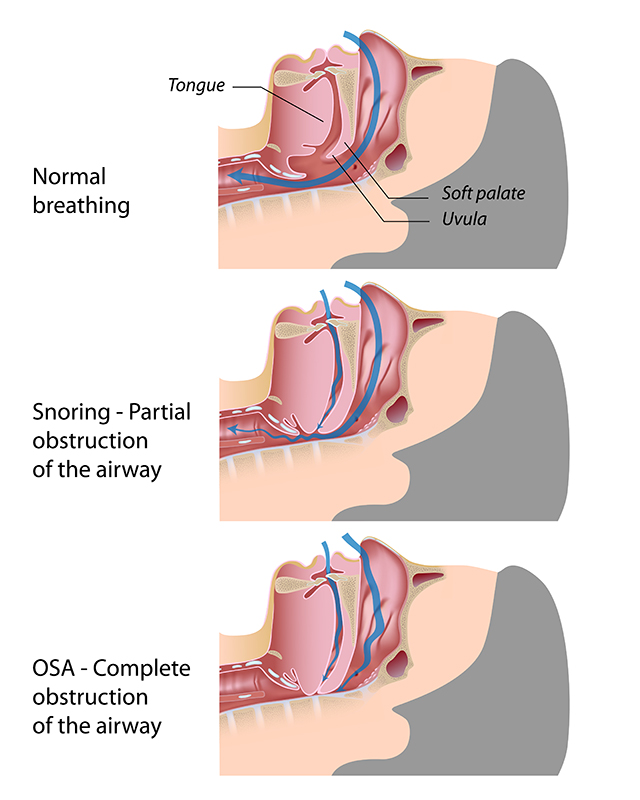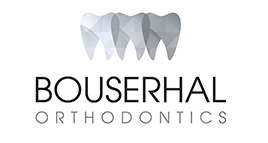Do you snore at night? Does any of your children snore at night?
If yes, this is a sign that shouldn’t be ignored. For better guidance, consult Bouserhal Orthodontics. Dr Bouserhal is specialized in the treatment of Obstructive Sleep Apnea (OSA).
Do I suffer from OSA?
Snoring, the first sign of sleep apnea, is usually detected by your loved ones. They may also notice an impression of suffocation while you sleep.Other common symptoms include excessive daytime sleepiness, lack of concentration, morning headaches, mood changes, night sweats, weight gain, lack of energy and frequent urination at night.
What happens to the person suffering from sleep apnea during his sleep?
When we sleep, the muscles and soft tissues located at the back of the throat (base of the tongue, uvula, soft palate …) tend to relax and reduce the opening allowing the air passage.
In sleep apnea, these muscles collapse completely, causing a stop of breathing that can last 10 seconds or more.
Our brain realizes that we are not breathing anymore, forces us to wake up to catch our breath, then we sleep again and the cycle begins again. This phenomenon can happen more than 50 times per hour even if we do not remember it.

Why do you have to treat sleep apnea?
Sleep apnea affects our well-being and our safety by multiplying by 4 the risk of road accidents.Untreated patients can develop diseases: Diabetes, stroke, heart failure, coronary artery disease, high blood pressure, obesity, memory loss, depression, bruxism and periodontal disease.
Does the treatment depend on the age and severity of the sleep apnea?Yes, there are several therapeutic options for adults:
• Weight loss to decrease the amount of fat tissue that infiltrates the muscles of the throat and neck.
• Continuous Positive Pressure (CPP): Applied to the airways through a tube and mask that covers the nose and mouth during sleep, it is a pneumatic splint that clears the obstructed airways.
• ENT surgery: It widens the airways to avoid obstructions, with a variable success rate.
• Mandibular Advanced Device (MAD): This consists of placing a two-piece device on the upper and lower teeth. Comfortable and easy to use, MAD is also a solution for mild and moderate cases as well as for severe cases that do not respond to other treatments. Apnea is cured by moving the lower jaw forward. This therapeutic position for the lower jaw prevents the patient’s airways from sagging during sleep.
• Orthognathic surgery of bimaxillary advancement: This radical solution of esthetic order remains limited by the operative risk.
How to diagnose sleep apnea in children?
It is especially the parents who detect a breathing problem in the child when he sleeps. As for the pediatrician, he may notice a disruption of the growth or weight gain curve and refer parents to a specialist in sleep disorders.
Examinations will then be proposed: an exploration of the nasal passages and throat by the ENT, a polysomnography (examination of the sleep with an apparatus), a radiography of the face and the throat …The specialist may also ask the parents to film the child while he is sleeping.

What are the risk factors leading to sleep apnea?
- Weight excess.
- Regular snoring.
- Family history of sleep apnea or snoring syndrome.
- Reduced airways due to a large tongue or a retreaded chin.
Is the clinical examination sufficient to make the diagnosis?
Sometimes more objective medical tests are used:- Polysomnography (PSG), an examination conducted at night in a sleep center or hospital.- Polygraphy, a test done at home thanks to a device evaluated later at the center of sleep.

What are the main causes of apnea in children?
90% of cases are due to increased volume of adenoids and tonsils!Between 2 years and 6 years old, the child begins to develop his own immunity, in parallel with the increase of the volume of his organs. In some children, an immune reaction of an unknown cause involves a volumetric increase in adenoids and tonsils beyond their normal physiological size.Sometimes sleep apnea occurs in children for other reasons: obesity, maxillofacial anomalies, myopathies …
The symptoms not to be missed!
– The child snores or breathes loudly.- He stops breathing even though his chest is rising (we cannot hear the sound of breathing anymore).- He seems to “catch his breath” after several seconds of respiratory arrest.
– When stripped, the muscles of the neck and torso stretch to the breath, revealing the ribs.- He chooses unusual sleeping positions to better find his breath (hyperextension of the head …).
– He has urinary incontinence during sleep (enuresis).- He is tired on waking and during the day even if he has slept the necessary number of hours. He can’t concentrate in class, is grouchy, hypersensitive or hyperactive and excitable.
– He has irregularities in the growth curve.
What are the consequences of untreated sleep apnea in children?
• A delay in growth: The child eats less because of his bulky tonsils and spends more calories at night to fight airway obstruction.
• General health problems: Heart problems, hypertension, obesity.
• A deficiency of the intellectual development: the brain is deprived of a sufficient rate of oxygen, which affects the development of the intellectual and cognitive capacities of the child, hence certain learning disorders, of concentration, of the memory and behavioral disorders such as hyperactivity or drowsiness (daily naps take place after school).
• Facial growth problem: Oral breathing and low tongue position may cause narrowing of the upper jaw and downward rotation to the back of the lower jaw.
